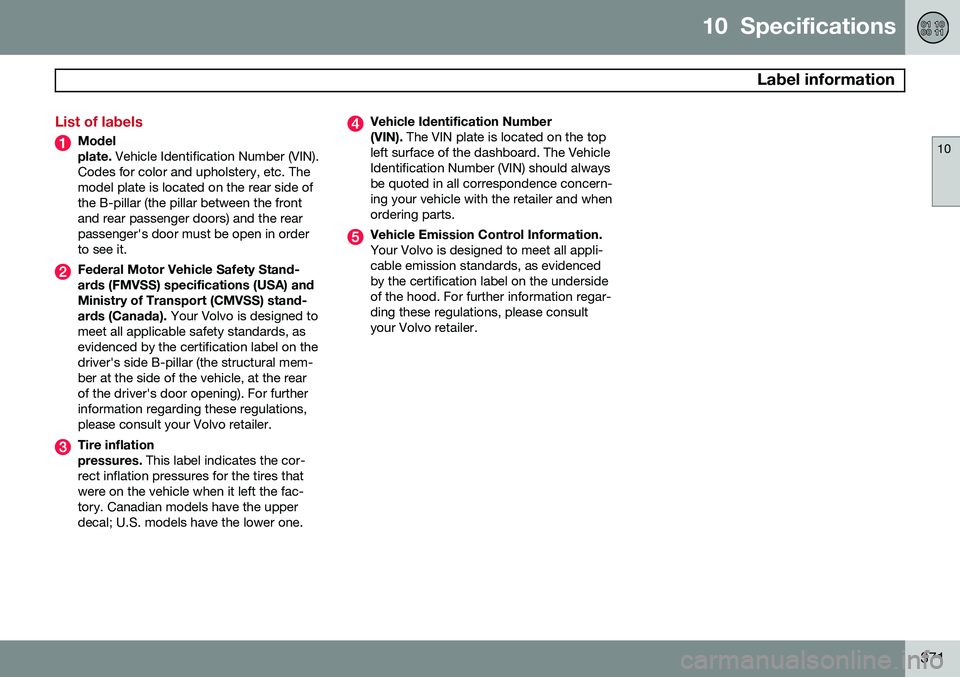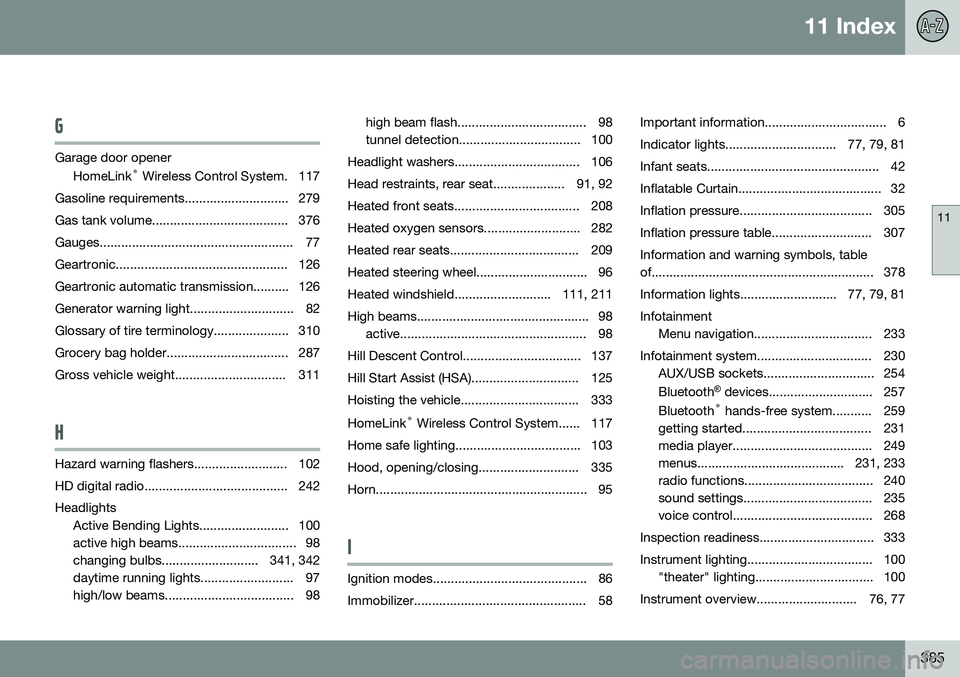2014 VOLVO XC70 hood open
[x] Cancel search: hood openPage 74 of 394

02 Locks and alarm
Alarm
02
72
The alarm system
The alarm is automatically armed whenever the vehicle is locked with the remote key oroptional Personal Car Communicator. When armed, the alarm continuously moni- tors a number of points on the vehicle. Thefollowing conditions will trigger the alarm:• The hood is forced open.
• The tailgate is forced open.
• A door is forced open.
• The ignition slot is tampered with.
• An attempt is made to start the vehicle with a non-approved key (a key notcoded to the car's ignition).
• The battery is disconnected (while thealarm is armed).
• The siren is disconnected when the alarmis disarmed.
A message will appear in the information dis- play if a fault should occur in the alarm sys-tem. Contact a trained and qualified Volvoservice technician.
NOTE
Do not attempt to repair any of the compo- nents in the alarm system yourself. Thiscould affect the insurance policy on thevehicle.
The alarm indicator light
The status of the alarm system is indicated by the red indicator light on the dashboard (seeillustration):
• Indicator light off: the alarm is not armed
• The indicator light flashes at one-second intervals: the alarm is armed
• The indicator light flashes rapidly beforethe remote key is inserted in the ignitionslot and the ignition is put in mode
I: the
alarm has been triggered.
Arming the alarm
–Press the Lock button on the remote key. One long flash of the turn signals will con-firm that the alarm is armed.
Alarm confirmation settings can be changed in MY CAR , under
Car settingsLock
settings
Keyless entry. See page 199 for
a description of the menu system.
USA FCC ID: MAYDA 5823(3) This device complies with part 15 of the FCC rules. Operation is subject to the followingconditions: (1) This device may not causeharmful interference, and (2) this device mustaccept any interference received, includinginterference that may cause undesired opera-tion. Canada IC: 4405A-DA 5823(3)
This device is subject to the following condi- tions: (1) this device may not cause interfer-ence, and (2) this device must accept anyinterference, including interference that maycause undesired operation of the device.
Page 79 of 394

03 Your driving environment
Instruments and controls
03
}}
* Option/accessory, for more information, see Introduction.77
FunctionPage
Controls for menus and messages, turn signals,high/low beams, tripcomputer199, 102,97, 215
Paddles for manually shifting gears*126
Cruise control146
Horn, airbag95, 22
Main instrument panel77
Infotainment system/ Bluetooth hands-freecontrols230, 259
START/STOP ENGINE button86
Ignition slot86
Display for infotainment system functions andmenus230, 197
Hazard warning flashers102
Door handle–
FunctionPage
In-door control panels (power windows, mirrors,central locking button,power child safety locks)108, 110,69,53
Controls for the infotain- ment system and menus199, 230, 208
Climate system controls208
Gear selector125
Controls for active chas- sis (Four-C)*222
Wipers and washers105, 106
Steering wheel adjust- ment95
Parking brake134
Hood opening control335
Power seat* adjustment controls88
Lighting panel, buttons for opening fuel fillerdoor and unlocking thetailgate97, 280, 70
Instrument panel information displays
Information displays: analog instrument panel
Information displays: digital instrument panel* These displays show information on some of the vehicle's functions, such as cruise con-
Page 337 of 394

09 Maintenance and specifications
Hood and engine compartment09
335
Opening and closing the hood
G010951
Pull the lever located under the left side of the dash to release the hood lock.
Lift the hood slightly. Press the release control (located under the right front edgeof the hood) to the left, and lift the hood.
WARNING
Check that the hood locks properly when closed.
Engine compartment, overview
Coolant expansion tank
Power steering fluid reservoir
Dipstick-engine oil
Filler cap-engine oil
Cover over brake fluid reservoir
Battery
Relay/fuse box
Washer fluid reservoir
The appearance of the engine compartment may vary depending on engine model.
WARNING
The cooling fan (located at the front of the engine compartment, behind the radiator)may start or continue to operate (for up to6 minutes) after the engine has beenswitched off.
WARNING
Before performing any operations in the engine compartment, the ignition shouldalways be completely switched off (inmode 0, see page 87) and there should be
no remote keys in the passenger compart-ment. The gear selector should be in the P
(park) position. If the engine has been run-ning, wait until it has cooled before touch-ing any components in the engine com-partment. The distributor ignition system operates at very high voltages. Special safety precau-tions must be followed to prevent injury.Always turn the ignition off when:
• Replacing distributor ignition compo- nents e.g. plugs, coil, etc.
• Do not touch any part of the distributorignition system while the engine is run-ning. This may result in unintendedmovements and body injury.
Page 373 of 394

10 Specifications
Label information
10
371
List of labels
Model plate. Vehicle Identification Number (VIN).
Codes for color and upholstery, etc. The model plate is located on the rear side ofthe B-pillar (the pillar between the frontand rear passenger doors) and the rearpassenger's door must be open in orderto see it.
Federal Motor Vehicle Safety Stand- ards (FMVSS) specifications (USA) andMinistry of Transport (CMVSS) stand- ards (Canada). Your Volvo is designed to
meet all applicable safety standards, as evidenced by the certification label on thedriver's side B-pillar (the structural mem-ber at the side of the vehicle, at the rearof the driver's door opening). For furtherinformation regarding these regulations,please consult your Volvo retailer.
Tire inflation pressures. This label indicates the cor-
rect inflation pressures for the tires that were on the vehicle when it left the fac-tory. Canadian models have the upperdecal; U.S. models have the lower one.
Vehicle Identification Number (VIN). The VIN plate is located on the top
left surface of the dashboard. The Vehicle Identification Number (VIN) should alwaysbe quoted in all correspondence concern-ing your vehicle with the retailer and whenordering parts.
Vehicle Emission Control Information. Your Volvo is designed to meet all appli- cable emission standards, as evidencedby the certification label on the undersideof the hood. For further information regar-ding these regulations, please consultyour Volvo retailer.
Page 387 of 394

11 Index
11
385
G
Garage door openerHomeLink ®
Wireless Control System. 117
Gasoline requirements............................. 279
Gas tank volume...................................... 376
Gauges...................................................... 77
Geartronic................................................ 126
Geartronic automatic transmission.......... 126
Generator warning light............................. 82
Glossary of tire terminology..................... 310
Grocery bag holder.................................. 287
Gross vehicle weight............................... 311
H
Hazard warning flashers.......................... 102
HD digital radio........................................ 242Headlights Active Bending Lights......................... 100
active high beams................................. 98
changing bulbs........................... 341, 342
daytime running lights.......................... 97
high/low beams.................................... 98 high beam flash.................................... 98
tunnel detection.................................. 100
Headlight washers................................... 106
Head restraints, rear seat.................... 91, 92
Heated front seats................................... 208
Heated oxygen sensors........................... 282
Heated rear seats.................................... 209
Heated steering wheel............................... 96
Heated windshield........................... 111, 211
High beams................................................ 98 active.................................................... 98
Hill Descent Control................................. 137
Hill Start Assist (HSA).............................. 125
Hoisting the vehicle................................. 333 HomeLink ®
Wireless Control System...... 117
Home safe lighting................................... 103
Hood, opening/closing............................ 335
Horn........................................................... 95
I
Ignition modes........................................... 86
Immobilizer................................................ 58 Important information.................................. 6
Indicator lights............................... 77, 79, 81
Infant seats................................................ 42
Inflatable Curtain........................................ 32
Inflation pressure..................................... 305
Inflation pressure table............................ 307Information and warning symbols, table
of.............................................................. 378
Information lights........................... 77, 79, 81Infotainment
Menu navigation................................. 233
Infotainment system................................ 230 AUX/USB sockets............................... 254 Bluetooth ®
devices............................. 257
Bluetooth ®
hands-free system........... 259
getting started.................................... 231
media player....................................... 249
menus......................................... 231, 233
radio functions.................................... 240
sound settings.................................... 235
voice control....................................... 268
Inspection readiness................................ 333
Instrument lighting................................... 100 "theater" lighting................................. 100
Instrument overview............................ 76, 77